Georeferencing Natural History Collections Botany2014: Difference between revisions
No edit summary |
No edit summary |
||
| Line 11: | Line 11: | ||
|[https://www.idigbio.org/wiki/index.php/Georeferencing_Natural_History_Collections_Botany2014#Agenda Georeferencing Natural History Collections Botany2014 Agenda] | |[https://www.idigbio.org/wiki/index.php/Georeferencing_Natural_History_Collections_Botany2014#Agenda Georeferencing Natural History Collections Botany2014 Agenda] | ||
|- | |- | ||
|[https://www.idigbio.org/biblio? | |[https://www.idigbio.org/biblio?f%5bkeyword%5d=419 Georeferencing Natural History Collections Botany2014 Biblio Entries] | ||
|- | |- | ||
|Georeferencing Natural History Collections Botany2014 Report | |Georeferencing Natural History Collections Botany2014 Report | ||
Revision as of 13:03, 18 December 2014
The digitization of biological specimens is transforming natural history collections for an array of novel research applications, permitting the utilization of large-scale data sets from the comfort of one’s own desk. Studies using digitized data include niche modeling, phylogeography, range/distribution investigations, and conservation and biodiversity management, to name just a few. All of these uses require dependable occurrence records for each specimen’s original location. For most specimens in natural history collections, locality data are represented by text. However, to be maximally useful, locality information should be presented as geographic coordinates. Georeferencing – the assignment of geographic coordinates to locality data – allows collection events to be displayed on digital maps and used in applications to visualize the spatial and temporal intensity of scientific collecting activity, examine species distributions, develop ecological niche models, and address a range of scientific and societal needs such as conservation, ecological restoration, and preparation for global change. This one-day workshop will introduce its participants through a combination of lectures and hands-on exercises to the fundamental background, techniques, and best practices of georeferencing of biological specimens. While no background in georeferencing is required, participants will need to bring their own laptops for the hands-on exercises.
| Georeferencing Natural History Collections Botany2014 | |
|---|---|
| Quick Links for Georeferencing Natural History Collections Botany2014 | |
| Georeferencing Natural History Collections Botany2014 Agenda | |
| Georeferencing Natural History Collections Botany2014 Biblio Entries | |
| Georeferencing Natural History Collections Botany2014 Report | |
Supporting Documents
- Introduction- Pam Soltis
- Georeferencing 101- Blaine Marchant
- Paper Maps- Blaine Marchant
- https://www.idigbio.org/sites/default/files/workshop-presentations/botany2014/GeorefLab2.xlsx
Agenda
Remote Participation
Broadcast of the workshop via Adobe Connect
Workshop Recordings
- http://idigbio.adobeconnect.com/p107fhtii9i/
- 8:00 Overview: digitized data and uses– Pam
- 8:30 Specimens and sources of data– Shawn
- 8:45 Georeferencing concepts– Blaine
- http://idigbio.adobeconnect.com/p9bqf4wb8ig/
- 10:00 Locality data exercise-outside
- http://idigbio.adobeconnect.com/p10wya5yamj/
- 11:00 Paper maps exercise– Blaine
